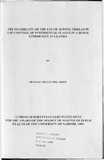| dc.contributor.author | Okullo, Isaac | |
| dc.date.accessioned | 2013-05-24T11:48:59Z | |
| dc.date.available | 2013-05-24T11:48:59Z | |
| dc.date.issued | 1999 | |
| dc.identifier.citation | Degree of Master of Public Health (M.P.H.) of the University of Nairobi | en |
| dc.identifier.uri | http://erepository.uonbi.ac.ke:8080/xmlui/handle/11295/25390 | |
| dc.description | A thesis submitted in part fulfillment for the Degree of Master Of
Public Health University of Nairobi | en |
| dc.description.abstract | A study was carried out to establishing the feasibility of using sewing thread for inter-dental
plaque control in rural school children. This was achieved by assessing whether the awareness of
the pupils on dental health care could be raised and the skills of inter-dental cleaning using
sewing thread imparted to them through dental health education and oral hygiene instructions by
trained Community Health Workers (CHWs). The efficacy of sewing thread in the control of
inter-dental plaque was also determined.
Three village schools were randomly selected and randomly assigned as clusters into the three
study groups. Each study group comprised 51 pupils aged 12-15 years randomly selected from
each of the three schools, making a total of 153 subjects The respondents were interviewed to
determine their knowledge and practice in oral health using structured questionnaires. This was
done before and after receiving oral health education from the CHWs. The CHWs gave oral
hygiene instructions (OHI) to pupils in their respective schools.
To determine the efficacy of sewing thread in plaque control, one group used sewing thread, the
second group used dental floss and the third group, the control group, used neither floss nor
thread for inter-dental cleaning. Tooth brushing was used in all the study groups to eliminate it as
a confounder. The effectiveness of the measures was determined by evaluating the plaque score
using plaque index according to Greene and Vermillion. The gingival score was determined
using the gingival index according to Loe and Silness. Both the plaque and gingival indices were
determined before and after the intervention. T - test and Analysis of Variance (ANOVA) were
performed on the mean plaque and gingival scores.
Using a pre determined criteria for determination of knowledge and practice, the level of
knowledge of the respondents was found to be raised by about 19% following oral health
education. Over 90% of the subjects who used sewing thread for inter-dental cleaning in this
study expressed a liking for it. There was no statistically significant difference in the plaque and
gingival scores between those who used thread and those who used floss for inter-dental plaque
cleaning (p > 0.05). This indicated that thread was as effective as floss in the cleaning of interproximal
areas. There was however a statistically significant difference in the scores between
thread users and the control, and between floss users and the control ( p < 0.05) indicating that
both thread and floss were effective in the control of inter-dental plaque. The use of sewing
thread resulted in the reduction of plaque and gingival index by 20% and 12% respectively while
those who used floss had a reduction of 23% and 16% in the plaque and gingival index
respecti vel y.
It was concluded that it is possible to successfully use sewing thread for inter-dental plaque control
in a rural setting. Therefore it is hereby recommended that thread be used for inter-dental cleaning
in the absence of floss. CHWs should also be trained in preventive oral health care to enable them
serve not only school children but also the wider communities. | en |
| dc.language.iso | en | en |
| dc.publisher | University of Nairobi | en |
| dc.title | The feasibility of the use of sewing thread in the control of interdental plaque in a rural community in Uganda | en |
| dc.type | Thesis | en |
| dc.description.department | a
Department of Psychiatry, University of Nairobi, ; bDepartment of Mental Health, School of Medicine,
Moi University, Eldoret, Kenya | |
| local.publisher | Department of Public Health | en |

